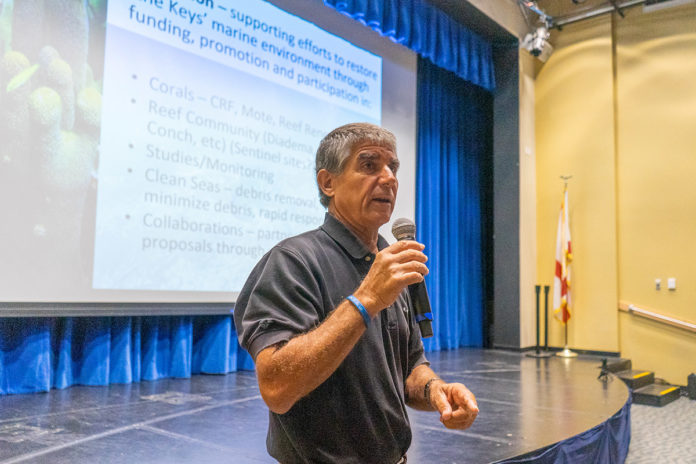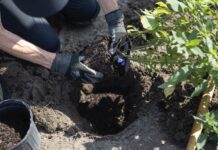
A newly-formed foundation is setting out to support the Florida Keys National Marine Sanctuary by connecting people to the ecosystem and inspiring stewardship.
Lad Akins, chapter director of the Florida Keys National Marine Sanctuary Foundation, recently spoke to the local Key Largo community during Florida International University’s Ocean Life Series lecture at the Murray Nelson Government Center. Akins is a longtime advocate for Florida Keys waters, serving as founding executive director of the Reef Environmental Education Foundation (REEF). He’s currently the CEO of Blue Earth Conservation. He began the presentation by outlining the goals of the foundation, which formed this year.
“We’re here to support the Florida Keys National Marine Sanctuary as a nonprofit in ways they cannot do as a governmental organization,” he said. “We want to be a sounding board for the community and the sanctuary.”
The foundation has four main priorities: restoration, community engagement, infrastructure, and compliance. Akins discussed real-world actions the foundation hopes to take within each category. For restoration, the foundation will support current efforts to restore the marine environment through the funding of restoration partners and research, the promotion of successful efforts, and active participation. Akins made clear that restoration doesn’t mean just corals, but rather the entire reef ecosystem.
To engage the community, the foundation will run public service announcements, media campaigns, educational talks and perhaps even a dive program to get volunteers into the sanctuary. Akins encouraged community members to become active stakeholders in the management of the sanctuary. Lisa Symons, regional response coordinator with the sanctuary, agreed.
“We’re looking at the community to help us steward these resources. We need your help to watch out for a particular patch of reef, to remove invasives, and to keep an eye out,” she said. “It’s going to be a long-term project, and we can’t do this without you.”
As for infrastructure improvements, Akins discussed the need for more mooring buoys, vessels, signage letting people know they’re in a sanctuary zone, and an interpretive center that would welcome visitors upon entering the Keys. A rotating buoy system and a mobile phone application were also suggested.
Finally, the foundation will look to use technology, awareness and increased enforcement capacity to bolster regulatory compliance. Akins acknowledged, “Officers don’t have enough people, equipment, and fuel. We’ll be working with the sanctuary and law enforcement to find out what they need and how we can make their jobs better and more effective.”
Akins concluded the talk with hope and an invitation to everyone in the room to “be a part of the solution.”
“Quite often we are told we want to minimize our footprint; we don’t want to leave a mark on the environment,” he said. “And I would challenge you to leave a footprint. We want to leave a big, huge, stomping footprint so that when we are gone, people will say that we were here and that we made it better than it was.”
“The coral reef ecosystem drives our economy and our local way of life,” Akins continued.
And while coral reefs make up only 0.25% of the seabed, they harbor 25% of nursery life for the ecosystem.




















